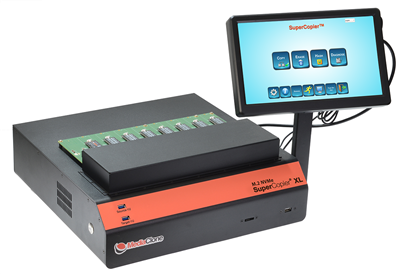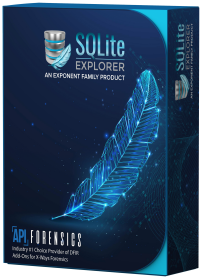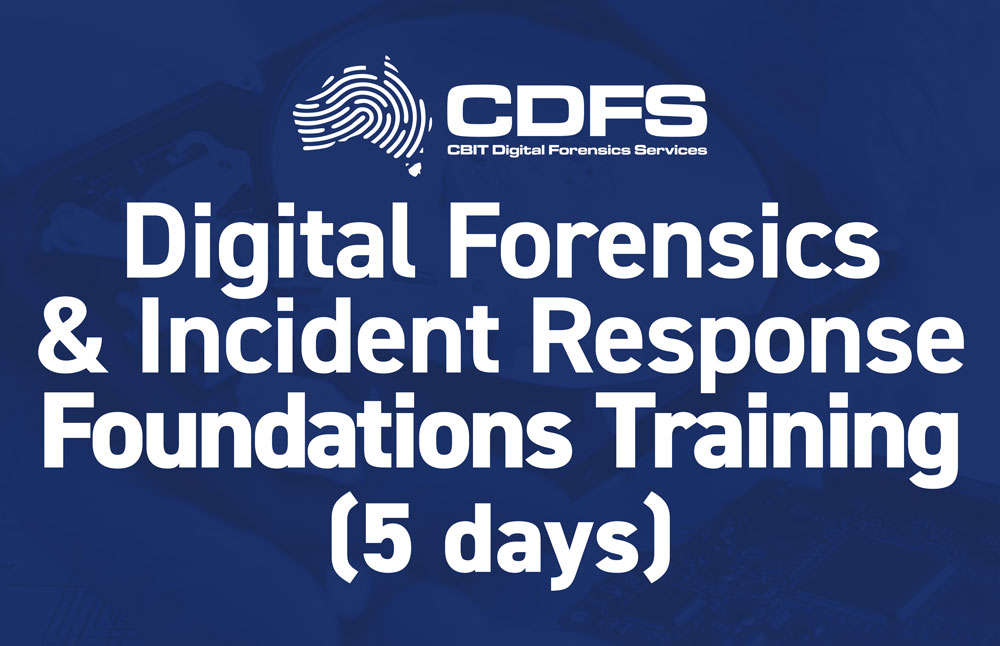
The SuperCopier® Desktop 8 M.2 NVMe SSD is an industrial, extremely fast (187GB/min), dedicated 8 M. 2 NVMe SSD drive duplicator running at full bandwidth and with easy insertion. It enables the user to easily clone, duplicate, and erase multiple drives simultaneously. The unit is designed with desktop chassis for long durability use. It supports NVMe SSD, e-SATA drives, and USB flash drives.
The main application supports many modes of operations, such as:
1) Mirror mode: Bit by bit imaging.
2) Quick Copy: Advanced Smart Copy of Partitions.
3) VHD copy: Clone image of a virtual drive.
4) Selective Capture of Files and Folders.
5) Copy to Folder: Copy all data files from a source drive into one folder on the target drives.
Here are some test results:
1) Cloning from one Samsung 128GB NVMe SSD to WD Black 1TB NVMe SSD at 187 GB/min
2) Clone + HASH from one Samsung 128GB NVMe SSD to WD Black 1TB NVMe SSD at 117 GB/min
3) Erase + Verify WD Black 1TB NVMe SSD at 130 GB/min.
The application supports data duplication from one source drive to multiple target drives or from multiple source drives to multiple target drives in multi-sessions. The application is updated to clone Windows 10/11.
The unit include 10″ Touchscreen display
There are many cloning and imaging standalone applications; only a few are working properly!
Features
Standalone, Secure, No License Scheme, M.2 NVMe SSD Drives Duplicator, Built with Extreme Performing Hardware, Heavy Duty, Easy to Use, and Very Flexible User Interface. Standalone hardware gives the user consistent performances and is the most secure solution. With no licensing scheme, it makes the solution cost-effective. In addition, it comes with free s/w updates and supports for the product’s lifetime. The unit runs 24/7, 365 days of the year, with no failure.
Application Features:
• Scaling NTFS, FAT32, and EXFAT partitions.
• One of the best NTFS scaling down apps.
• Copy/Erase Bitlocker encrypted partitions.
• Win8, Win10 support.
• Supports MBR and GPT partitioning.
• S.M.A.R.T. drive’s diagnostics tests.
• Read-back-verify drive test.
• Remove ATA passwords*
* some drive models
• For NVMe SSD, the application Supports:
-Copy NVMe SSDs
-NVMe namespaces
-NVMe erase/format
Operation Highlights:
• Hot swapping Ports: Each unit’s port is a hot swap port. When a session completes, the user can plug another drive and select it to run a new operation.
• Scripting: Easy Scripting can be set and used for a repeat operation.
• Reporting: Detailed logs for drive duplication and drive erase sessions.
• SQL Erase Database: A collection of the erase logs, erase certificates, and drive information.
• Easy Export of Erase logs and the Erase database to a USB stick or share it over a network.
• Access/Control the unit remotely.
Example of a typical cloning operation:
For high volume:
M.2 NVMe SSD: clone 1 to 7 in one session.
USB 3.2: clone 1 to 9 in one session.
For a variety of source drives:
Any combination of the ports up to 4 to 4 for NVMe SSD in 4 simultaneous sessions and up to 5 to 5 for USB 3.2 flash drives in simultaneous sessions.
Technical Specs
SuperCopier Cloning Application Settings:
- HPA/DCO Automatic Supports: The application can automatically open HPA and DCO areas and resize the drive to its full native capacity to erase any “hidden data” (HPA/DCO are special areas on a SATA drive that support this feature).
- Bad Sectors Handling: The user can select to skip bad sectors/blocks or abort the operation when encountering bad sectors/blocks on the source drive.
- 48bit LBA Addressing: Supports drives with sizes up to 256TB.
Application Features:
- GUI: The SuperCopier application is designed with very simple and easy-to-navigate icons. The user can set the operation in a few clicks.
- Speed: Extremely fast operation – 100% bit by bit can be up to 160 GB/min with NVMe SSD.
The Application’s Main Operations:
- Clone: Mirror bit by bit (any OS), Quick Copy (NTFS, FAT, exFAT, HFS+, EXT2-4), Selective Capture (Folders and Files), VHD Copy, and Copy to Folder.
- Erase or Format.
- Drive Diagnostics.
- HASH Authentication.
Cloning/Duplication:
-
-
- Mirror Copy: 100% bit by bit mirror copy for any size of source and target drive with any OS. The source drive and the target drives need to be the same make and size if the user wants to boot from the target drives. The user can image a portion of the source drive by adjusting the % of the drive.
- Selective Capture: Enables the user to browse and select from the source drive partitions, folders and files to copy. Supported by a drive with a mountable partition under Linux (NTFS, FAT, exFAT, HFS, and EXT2-4).
- VHD Copy: Enables the user to copy VHD files from a source drive that contains multiple VHD files.
- Copy-to-Folder: Copy the entire drive and save it into one Folder.
- Quick Copy/Advanced Smart Copy mode: Cloning and deploying only the file system.
It supports source drives with FAT/NTFS/HFS+/EXT-2-3-4 file systems. Automatically scans for all the partitions on the source drive. Option to scale all partitions, or scale only selective partitions, by user’s selection and choice, and option not to scale partitions.
-
Scale-Down partitions:
-
- If the size of the “data” on the source drive (not the size of the source drive!) will fit the target drive, then the quick copy will be completed. If the data on the source drive does not occupy the whole drive, the user can copy it to a smaller drive (for example, if the data occupied only 200GB on 1TB source drive, then the target drive can be 200GB, and cloning from 1TB to 200GB will work).Example of cloning with NTFS scaling down operation: Run a bench test with a 160GB source drive containing two NTFS partitions: 1) 100MB boot partition 2) remaining is Windows partition. The target drive was 120 GB, and the data load size was 16.4 GB. The “data” was fragmented, and a previous s/w revision could not succeed in copying it into an 80 GB target drive. The new, improved s/w version enables the target drive to shrink from a size of 120GB down to 23.5GB!
Supports for Scale-Down partition:
-
- Is not supported for EXT2-4 nor HFS+. Automatically formats and partitions the target drives On-the-fly while the duplication runs.
- Verification of the copied data/Built-in data transfer verification. For 100% bit by bit mirror copy: The user can select to add an optional HASH calculation value during the data transfer (MD5, SHA-1, SHA-2) as authentication and verification of the copied data. MD5 is the fastest mode, and it almost adds not delays the total copy time. For an extra precaution, the user can also enable the option to “HASH target drives and compare” which will run an additional read-pass over the target drives at the end of the copy, calculate a HASH value by reading the data from the target drives, and compare the HASH values to the one that was generated from the source drive. That extra step adds some spare time; for example, running 100% bit by bit copy from 1TB source drive to 15 of 1TB target drives can take around 2h. “HASH the target drives and compare” can add another hour to the total time.
Erase and Format Operation:
-
- Drive Erase Protocols: DoD 5220-22M(Total 8 pasess), DoD Lite (Total of 4 passes), Security Erase(NIST), Enhanced Security Erase, Sanitize (SAS SSD), NVMe security erase/format (NVMe SSD), or User-Defined Final Data Filling Pattern and the number of erase iterations (all erase protocols are NIST 800-88 compliance).
- Drive Formats: NTFS, FAT, exFAT, HFS+, and EXT4.
Drive Diagnostics Operation:
-
-
- Drive Diagnostics tests and S.M.A.R.T. drive tests: If the user intends to erase a drive for re-use purposes, it is recommended to run some “Health test” on the drive before the erase process. There are three available types of tests:
- Read-Verify: Supported by all storage protocols.
- Short Test (2-5 minutes): The application scans random areas on the drive.
- Extended Full Test (It can take hours to run): The application scans the entire drive.
- S.M.A.R.T. supported; Only by SATA/SAS/SCSI storage protocols.
-
Logs, Erase Certification and databases:
-
- The application generates extensive erase and diagnostics log files, erase and diagnostics databases, and erase certifications (option to save to NIST 800-88 format) easy to export to USB flash drives. The user can add his company logo to the erase certification and add additional info on the erase runs that will append to the certificate.
Parallel Operations/Versatility with Multiple Cloning Sessions:
-
- Every drive cloning session must include one source drive and at least one target drive (The application supports cloning from one source to multiple targets). Also, numerous cloning sessions can run simultaneously. To run multiple cloning, the user needs to configure (reassign its role) some of the target ports to be source ports. For example, The SuperCopier desktop 8 SAS/SATA ports unit is configured with the first port as Source + Target 1-7 ports, so one possible cloning session: Source 1 ->Target 1+Target 2, Source 3->Target 4 (Where, in this case, the user reassigned Target 3 port to be Source 3). Another possible cloning session is to run four simultaneous cloning sessions of 1:1 can be achieved: Source 1 ->Target 1, Source 2->Target 3, Source 4->Target 5, Source 6->Target 7 (Where, in this case, the user reassigned Target 2, to be Source 2, Target 4 to Source 4, Target 6 to be Source 6). and many more possibilities. In addition, the user can select to run another type of operation in parallel to the cloning session, like HASH, Drive Diagnostics, Drive Erase, and more.
Drive Detection Application Screen:
-
- All drives and storage devices connected to the unit will be scanned and displayed on “The Detection Screen” screen. The user can tap on each drive model to get the drive’s detailed info and perform a specific operation on that drive, like resizing it. Also, the user can select the drive to run into the operation.
Continuous Mode:
-
- The user can run continuous operations with multiple sessions. Each storage device attached to the unit can be selected to run in an independent session. Each session does run independently of the other and can run simultaneously to maximize the use of the machine. When a session is completed/aborted regardless of the status of the other running sessions, the user can replace those storage devices with another one and start a new session – That is a continuous operation.
Multiple Sessions Application Screen:
-
- All running sessions are displayed in one “Application Screen”. The “Application Screen” shows the name of the session, the operation of the session, the error or abortion flag, the progress completion bar, and the successful completion flag. The user can abort a session, tap on a session to monitor its real-time running progress, and get the specific detailed setting for that run. It is a straightforward way to view, navigate, and control the sessions.
Speed of cloning and erase:
-
-
- For Erase Operation: The total erase time depends on the drive makes/model and size. It does not matter how many drives are connected to the unit since the CPU is very powerful and utilizes many cores to achieve max speed optimization.
- For Cloning Operation: Quick Copy is slower than mirror imaging since it takes more time for the application to calculate and create the file system, but overall it is much faster since it does not need to clone empty spaces.
-
More Features:
-
- The Unit’s User Configuration: This feature allows the administrator of the unit to set specific operations with specific settings and allows the user to secure it with a lock password (This feature needs to be requested at the time of purchasing the main unit – it is needed for security purposes).
- Tasks Scripting: The user can create a script enable the application to run sequential and parallel operations. There are no limitations on the number of scripts and operations.
- Language Supports: Easy to implement translations for new languages. (Korean and Chinese are supported).
- Settings: The user can save its setting, load a saved setting, or tap on the default setting.
- Set time and day: The user can set the Date and Time.
- Warranty: One year on the main unit, not include cables and accessories.
- Built-in the US: The units are built and tested in the US.
Extended Information
Main Hardware Features:
-
- Form Factor:Desktop, Industrial Built, Last for years.
- CPU: i9 Latest generation.
- Display: 10″ touchscreen, color LCD display.
- Hardware: Very high-quality, high performing components; some with military specifications.
- OS: Linux Ubuntu 64 bit.
- Security: Linux OS (Linux is less targeted by malware).
- Dedicated Secure Unit: Clone, Erases and Formats storage devices (HDD, SSD, USB storage devices, and Multi Media Cards).
Hardware Specifications:
- Storage controller: Two 4 Ports NVMe storage Controller
- 48bit LBA Addressing: Supports drives with sizes up to 256TB.
Hardware Supports:
- Supports Storage Protocols and Interfaces: SATA, e-SATA enclosures, IDE, USB3.2, MMC, M.2 NVMe.
- Supports Form Factors: M.2 storage devices.
- Clone and Erase Multi-Media Cards: Supports SD/CF/Memory Stick/microSD with the use of a Multi-Media Card reader via a USB port.
- Main Native Ports: 8 M.2 NVMe ports data and power, 10 USB 3.2 ports, one e-SATA port.
- Power Characteristics: Built-in a universal auto switching 700 Watt UL/CE/PSE.
- Operating Environment: 5°C – 55°C (40°F-130°F), relative humidity: 20-60% non-condensing.
- Mechanical Characteristics:
-
- Unit Dimensions:The base unit’s dimensions: 18.0″ x 15.0″ x 4.0″ inch.
- Unit Net Weight: 32.00 LBS.
- Shipping Dimensions:
Box Dimensions: 20″ x 20″ x 15″ inch & Box Weight: 35.00 lbs.
-
Optional Items:
USB memory card reader
USB3.0 to e-SATA Adapter
M.2 NGFF to USB3.0 Adapter (SATA or PCIE base)
USB3.0 to SATA 4 Channel Kit convert 4 USB3.0 ports to 4 SATA ports at high speed (Up to 20GB/min). The kit includes 4 USB3.0 to SATA hard drive adapters and 1 PS to power 4 hard disk drives



